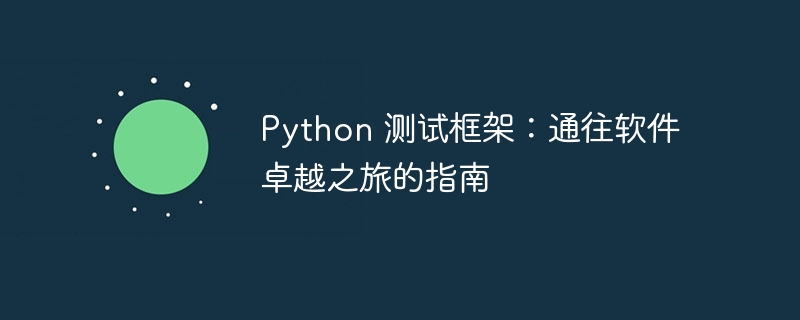Home >Backend Development >Python Tutorial >Python Testing Framework: A Guide to Your Journey to Software Excellence
Python Testing Framework: A Guide to Your Journey to Software Excellence
- WBOYWBOYWBOYWBOYWBOYWBOYWBOYWBOYWBOYWBOYWBOYWBOYWBforward
- 2024-04-02 13:19:10655browse

In modern software development, testing has become a vital component in ensuring application quality and reliability. python As a popular programming language, it provides a rich testing framework to enable developers to write and execute tests efficiently Example.
Choose the appropriate testing framework
Python has a variety of testing frameworks, each with different features and focus. Here are some factors to consider when choosing the right framework:
- Type: Unit test, integration test, end-to-end test
- Function: Assertion, simulation, coverage report
- Ecosystem: Third parties Plugins and community support
Popular Python testing frameworks include:
- Unittest: Flexible unit testing framework provided in the Python standard library
- Pytest: A feature-rich framework that provides a wide range of assertions, fixtures and plugins
- Nose: A lightweight framework that emphasizes automation and scalability
- Behave: A behavior-driven development (BDD) framework that uses natural language to write test scenarios
- Selenium: Framework for end-to-end testing of WEB applications
Benefits of testing framework
The benefits of using a testing framework include:
- Improve code quality: With automated testing, developers can find errors and ensure that code behaves as expected.
- Improve productivity: The testing framework reduces the manual work of writing and maintaining test cases, allowing developers to focus on other tasks.
- Increase Confidence: By regularly executing tests, developers can be confident in the correctness of their code, thereby reducing defects and improving application reliability.
- Promote collaboration: The testing framework creates readable and maintainable test cases, promoting collaboration among team members.
- Support automation: The testing framework can automate the testing process through continuous integration tools to improve development efficiency.
Best Practices
To get the most out of the Python testing framework, follow these best practices:
- Write clear and concise test cases: Use meaningful names and clear assertions.
- Follow the testing pyramid: Focus on writing unit and integration tests, and add end-to-end tests as needed.
- Use mocks to isolate dependencies: Avoid real side effects in tests and use mocks to isolate dependencies.
- Implement continuous integration: Automate test execution and build and test code regularly.
- Use coverage reports: Understand test coverage and identify areas that need more testing.
in conclusion
The Python testing framework provides developers with powerful tools to improve application quality, increase productivity, and increase confidence. By choosing the right framework and following best practices, developers can get the most out of Python testing frameworks and embark on a journey to software excellence.
The above is the detailed content of Python Testing Framework: A Guide to Your Journey to Software Excellence. For more information, please follow other related articles on the PHP Chinese website!

